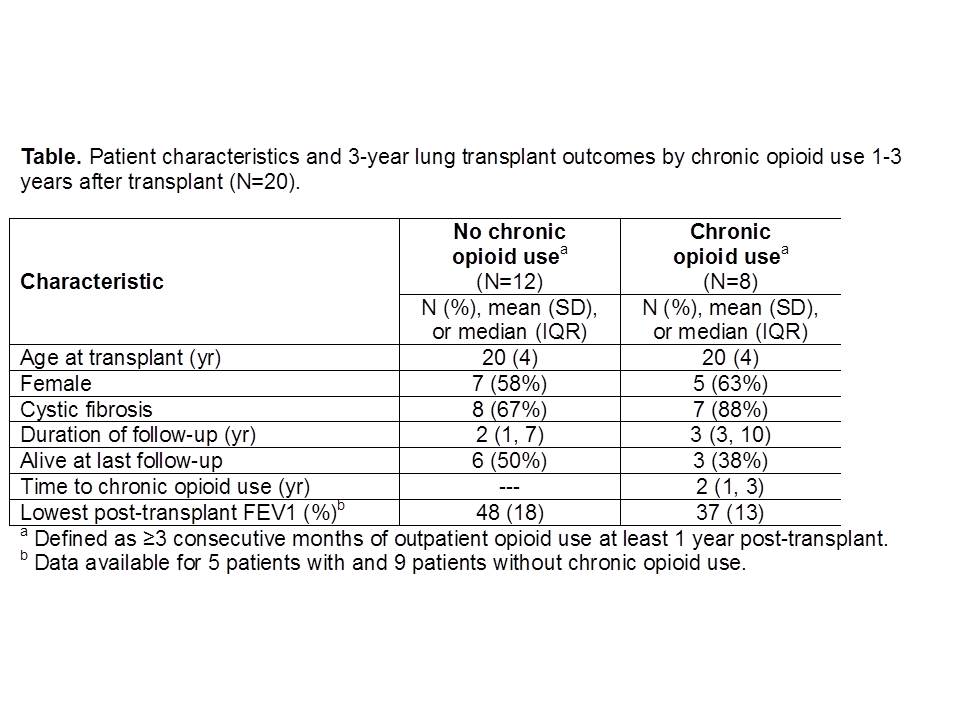PR2-167
Chronic opioid use and clinical outcomes in adolescent and young adult lung transplant recipients
Drees D, Tumin D, Kirkby S, Bhalla T, Tobias J, Hayes D
Nationwide Children's Hospital, Columbus, OH, USA
Introduction: Chronic pain is common in lung transplant (LTx) candidates and recipients, with one study estimating that 18% of LTx recipients experience persistent pain after surgery. Opioid therapy for chronic post-transplant pain was recently shown to predict increased risk of re-hospitalization and other adverse events in adult recipients of kidney and liver transplants. However, the association of long-term opioid use with LTx outcomes remains unclear. We performed a single-center retrospective review to compare LTx outcomes according to chronic opioid use among adolescents and young adults followed by our LTx program. We hypothesized that initiation of chronic opioid use would increase risks of mortality and lung function deterioration in this cohort.
Methods: Patients age 12 to 25 years at the time of LTx were selected for the study if they were followed up at Nationwide Children’s Hospital (NCH) within 3 years of the transplant. Early post-transplant deaths (<30 days) were excluded. Chronic opioid use was defined as outpatient use of opioids in ≥3 consecutive months, at least 1 year post-transplant. The date of the earliest chronic opioid use was noted. Study outcomes included 3-year mortality and, among patients with post-transplant pulmonary function testing (PFT) data, forced expiratory volume in 1 sec (FEV1, % predicted) over the first 3 years post-transplant. Cox proportional hazards models and mixed effects regression were used to account for chronic opioid use as a time-varying covariate.
Results: Twenty patients were included in the analysis, with a median follow-up time of 3 years. Eight patients (40%) had chronic opioid use noted, with median time to chronic opioid use of 2 years since LTx. Patient characteristics are compared by chronic opioid use in the Table. On univariate Cox proportional hazards regression, 3-year mortality hazard increased fivefold after the earliest episode of chronic opioid use (HR=5.3; 95% CI: 1.1, 26.0; p=0.041). On mixed-effects regression analyzing 173 PFT records from 14 patients, and adjusted for time since LTx, FEV1 decreased by 28% after the earliest episode of chronic opioid use (95% CI: 11%, 44%; p=0.001).
Discussion: In our single-center review, late onset of chronic opioid use after adolescent or young adult LTx was strongly associated with decreased lung function and increased mortality hazard by 3 years post-transplant. Evaluation of chronic opioid use should be included in the routine monitoring of transplant recipients, to better define the impact of this risk factor on LTx outcomes.
References:
1. Wildgaard K et al. Clin J Pain. 2010;26:217-22.
2. Rogal S et al. Clin Transplant 2016;30:1222-9.
3. Kulshrestha S et al. Clin Transplant 2014;28:1041-6.
4. Yusen RD et al. J Heart Lung Transplant 2016;35:1170-84.
5. Goldfarb SB et al. J Heart Lung Transplant 2016;35:1196-1205.
Top












